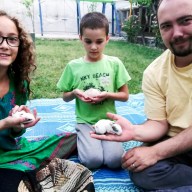julia dimon/for metro Toronto
From the capital Addis Ababa to Jinka in Southern Ethiopia, children have found creative ways to attract attention. A young boy painted in white balances on stilts in the hope tourists will stop to take his photograph.
Travel is the journey, not the destination. Though a cliché, this age-old saying best describes my trip from the capital city of Addis Ababa to Jinka in the Lower Omo Valley. A two-day drive at some 900 kilometres, just getting there is an experience in itself.
Along with the TV crew, I hop in the Dinknesh Tours 4 X 4 and prepare for an organized tour of Southern Ethiopia, home to some of the country’s most exotic indigenous groups. Road trip!
From the backseat, I watch as the landscape changes from the city smog of Addis to the rolling green hills of rural Ethiopia. The houses turn from concrete to thatched huts, the road turns from paved to pot-holed.
It’s too bumpy to sleep, too bumpy to read. There’s not much else to do other than stare out the window and enjoy the ride. The driver cranks the iPod, plugged in by a cord to the car radio, and we watch the scenery speed past.
Life here is simple. Donkey-pulled carts and trucks packed to the brim with passengers are the main form of transportation. Beehives in the shape of spring rolls dangle from Acacia trees. Children compete by the side of the road on faded green ping pong tables. In this part of the world ping pong is king; seems like every village has a table and a lineup of eager young players. Though much of the population lives in relative poverty, people look happy and healthy.
As we drive through town, children hold out their hands and holler. At first I think they’re greeting us. When I listen closer, I realize that those high-pitched voices are begging for empty Highland water bottles. “Highland, Highland, Highland,” they scream, running alongside the car, water bottles are like currency.
Clearly, foreigners equal aid and the result of that “generosity” is staggering. Along hundreds of kilometres, we see mobs of children who call out for plastic containers, pens and money.
To give or not to give? The car launches into a discussion on travel ethics and responsibility. As a tourist, being accosted for money is a reality all over the world, but it’s up to the individual to determine how they’re going to deal with it. Sometimes I falter but my overall policy is not to give to children. It has negative long-term effects, encourages a begging-culture and a reliance on tourist hand-outs. I argue that making a donation to a locally run organization is better than handing out bills of Birr to beggars.
Little kid entrepreneurs hang by the side of the road, anxious to perform for tourist dollars. Each area has its own set of child buskers with a different gimmick: A boy painted in white balances on stilts, another performs a traditional African dance. In other communities, the children weave glasses and toy trucks from reeds. If you want to take a photo, you must pay. The going rate is 1 Birr (1 cent Canadian) per photo.
As labourers work on improving road conditions so more tourists can visit Ethiopia’s south, I can’t help but wonder how this increase of traffic will negatively affect these already “tourist-touched” communities.
Freelance writer Julia Dimon is editor of The Travel Junkie and host of Word Travels, a new reality TV-series to be broadcast on OLN in 2008. Contact her at www.thetraveljunkie.ca.
















